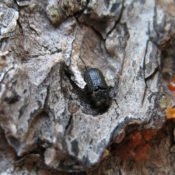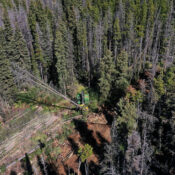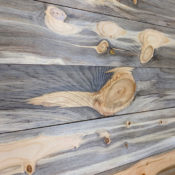Beetle Kill Pine Q&A
Posted: March 11, 2015 What is Beetle Kill Pine?
What is Beetle Kill Pine?
The millions of acres of dead pine trees riddled throughout the Western United States and Canada are better known as Beetle Kill Pine. The killer of these trees is the mountain pine beetle which bores into the wood, lays their eggs, and ultimately suffocates the tree by cutting off its water and nutrient supply.
The Mountain Pine Beetle is a member of a group of insects known as bark beetles. These beetles live out their life cycles within the bark of trees, except for when adults emerge and attack new trees. When outbreaks are extensive, millions of trees may be killed. What many people don’t know is that a small little beetle about the size of a grain of rice is the culprit and has killed millions of acres across Montana and the Rocky Mountain West.
As of 2022, the Pine Beetle epidemic has aggressively devastated forests in all 19 Western States and Canada, effectively decimating over 100 million acres of timber at an 80-90% kill rate.
So what happens to these trees?
After the beetle kills the tree it becomes known as “dead standing timber”. If harvested within 5 years these trees can still be used for wood products and sequester their carbon storage. If not harvested these trees are left to fall over and decay, resulting in millions of board feet of kindling in our forests. These trees become fuel for catastrophic wildfires or decay which ultimately release their carbon back into the atmosphere resulting in higher greenhouse gases.
Is the wood still good?
The beetle carries a fungus that slowly turns the wood into different colors. Commonly known as “blue stain” the colors that appear can range from blue, purple, brown, orange, yellow, red, and pink. The fungal staining is purely cosmetic and does not affect the structural integrity of the wood.
What are the most common uses of beetle kill pine?
Because of the natural discoloration and wide array of colors, beetle kill pine is commonly used to make blue pine wall planks and paneling, flooring, cabinets, doors, and furniture. The uniquely colored wood is prized by artisans and craftsmen across the globe. An all natural and organic product, no stains or paints are needed to color or enhance the wood.
What’s in store for our forests in the future?


Building awareness of what’s happening to our forests is the answer. Purchasing wood products manufactured from beetle kill pine helps sequester their carbon storage versus letting it burn or decay. Commonly purchased beetle kill pine products include siding, flooring, paneling, furniture, doors, cabinets, and molding.
We can lessen the severity of this epidemic with proper forest management, salvaging beetle killed pine trees, and reducing forest fuels.
Where can I purchase beetle kill pine products?
Sustainable Lumber Co. in Missoula Montana manufactures the highest quality prefinished and unfinished beetle kill pine flooring and blue Pine wall paneling on the market. Our products are shipped factory-direct anywhere within the U.S.
To learn more about Beetle Killed Pine, click here.
Contact us today for a free quote: Ph# 406.642.7120 or click here to submit an inquiry online.


